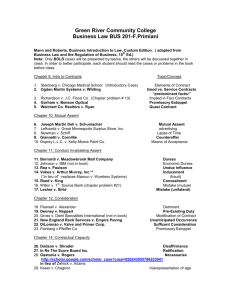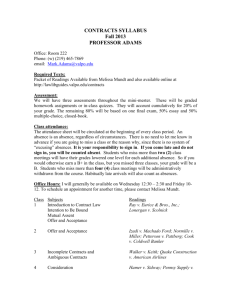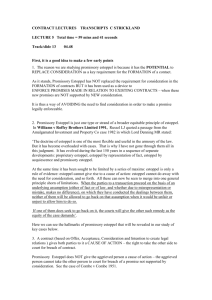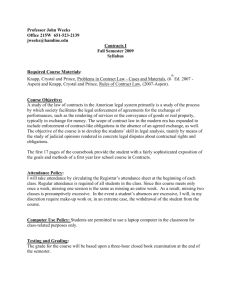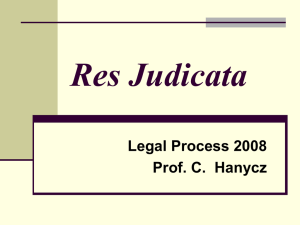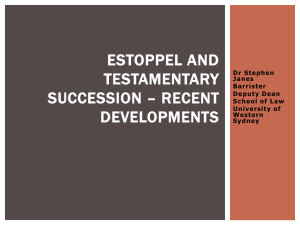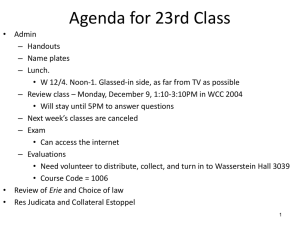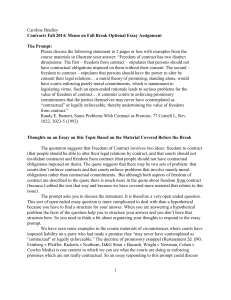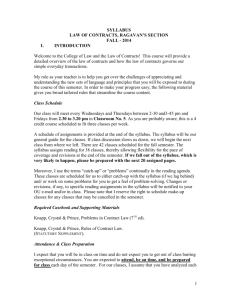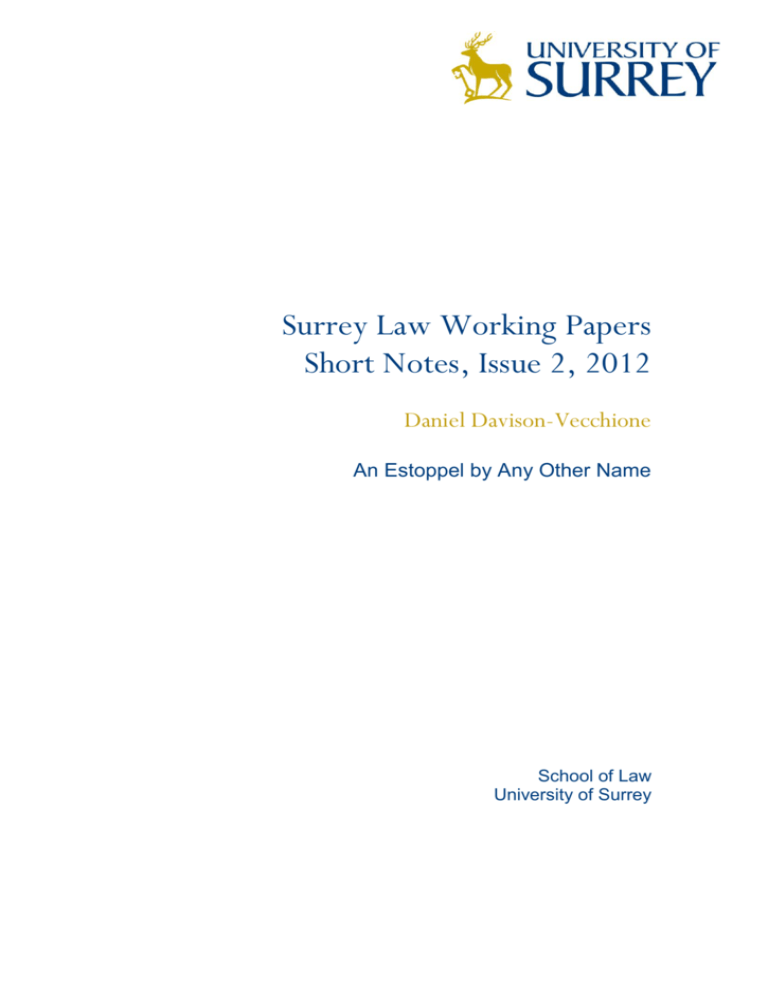
1
Surrey Law Working Papers
Short Notes, Issue 2, 2012
Daniel Davison-Vecchione
An Estoppel by Any Other Name
School of Law
University of Surrey
2
The Surrey Law Working Papers are published by Surrey Law School Publishing
(University of Surrey), School of Law, Austin Pearce Building, Guildford GU2 7XH.
All papers are reviewed before acceptance for publication.
Managerial Editors: Sanna Katariina Elfving; Pessi Honkasalo; Leonie Byers; Jack
Deung; Adrees Khan; Emile McHarsky-Todoroff; Oluwabunmi Oduntan; Ellena
Pearson; Geoffrey Pullen; Jade Rickman; Annie Rockson; Katie Simmonds
Editorial Board: Dr Kanstantsin Dzehtsiarou (School of Law, University of Surrey);
Dr Theodore Konstadinides (University of Surrey); Dr Jane Marriott (University of
Surrey); Dr Regina Rauxloh (University of Surrey).
Advisory Editors: Professor Indira Carr (School of Law, University of Surrey); Dr
Donal Coffey (University of Portsmouth); Dr Fiona de Londras (UCD); Prof Brice
Dickson (Queen’s University, Belfast); Dr Emily Finch (School of Law, University of
Surrey); Professor Alison Firth; Dr Brian Flanagan (NUI Maynooth); Prof John
Jackson (University of Nottingham); Mr Robert Jago (School of Law, University of
Surrey); Dr Oana Stefan (HEC Paris); Dr Thoko Kaime (School of Law, University of
Surrey); Dr Tobias Lock (University of Surrey; Dr Conor O’Mahoney (UCC); Dr
Renginee Pillay (School of Law, University of Surrey)
Working Papers for consideration and correspondence can be sent to Surrey Law
School Publishing (University of Surrey) (address given below) which can also
provide further information on editorial procedures and house style.
Editorial Office:
Surrey Law School Publishing (University of Surrey)
School of Law,
University of Surrey,
Austin Pearce Building,
Guildford GU2 7XH
E-Mail: K.Dzehtsiarou@surrey.ac.uk
All rights reserved.
© 2012 Daniel Davison-Vecchione
2012 Surrey Law School Publishing (University of Surrey).
No part of the material protected by this copyright notice may be reproduced, stored
in a retrieval system, or transmitted, in any form or by any means, electronic,
mechanical, photocopying, scanning or otherwise without written permission from the
copyright owner.
3
An Estoppel by Any Other Name
Daniel Davison-Vecchione
University of Surrey
Abstract
Estoppel has been recognised in a great variety of forms, but even today the dividing
lines between them are often left indistinct by judges. This is particularly true of the
two categories of equitable estoppel: promissory and proprietary. There are those who
argue that rigidly distinguishing the two is of little practical value. Others contend that
they have developed as distinct doctrines in their own right and should be treated as
such. Consequently, this article examines the evolution of the two estoppels and
whether they should, or even can, be combined into a single, coherent doctrine.
A. Introduction
Last year in ING Bank NV v Ros Roca SA a clause provided that an additional fee for
a bank’s financial services to a company would be calculated according to the ratio of
the enterprise value to the earnings prior to interest, tax, depreciation and amortisation
(‘EBITDA’) of 2006.1 The transaction was expected to take place that year, but it was
not completed until 2007, by which point the EBITDA 2006 figure had ceased to be
current. As the parties had operated under the shared assumption that the figure would
be based instead on the 2007 calculation, the Court of Appeal held that despite the
clause in the agreement, the bank was ‘estopped from saying that its calculation based
on EBITDA 2006’ was the correct one.2
This year in Newbold v Coal Authority, it was claimed that the defendant coal
authority was estopped from challenging the contested damage notices’ validity since
it was commonly assumed that the notices were valid from the date of service.3 On the
facts it was found by the Upper Tribunal that such an interpretation of estoppel would
confer upon the claimant a statutory right that he did not possess. As such, estoppel
could not operate to confer such a right ‘on him, a person lacking the interest required
by the Act’.4 Whilst successful in the first case and unsuccessful in the second, the
message conveyed by these claims of estoppel remains clear: no matter the extent to
which Lord Denning’s landmark resurrection of the doctrine in Central London
Property Trust Ltd v High Trees House Ltd5 was treated with reserve, suspicion and
even ‘silent disapproval’ by the higher courts, 6 estoppel is very much alive and
kicking.
Nevertheless, in the words of Viscount Hailsham in Woodhouse AC Israel Cocoa SA v
Nigerian Produce Marketing Co Ltd, the cases on estoppel since High Trees House
‘may need to be reviewed and reduced to a coherent body of doctrine by the courts’.7
This becomes especially significant in light of how English law has come to develop
1
[2011] EWCA Civ 353, [2012] 1 WLR 472.
ibid 499.
3
[2012] UKUT 20 (LC).
4
ibid [108].
5
[1947] KB 130 (KB).
6
Alfred Denning, The Discipline of Law (Butterworths 1979) 199.
7
[1972] AC 741 (HL) 758.
2
4
several forms of estoppel. Although the courts have recognised many specific
variations of the doctrine, such as estoppel by convention 8 and estoppel by
representation, 9 the two most readily noted in academia are certainly promissory
estoppel and proprietary estoppel. Whilst both are equitable in nature, the former
relates to promises not to enforce strict legal rights, whereas the latter relates to
assurances in respect of an interest in land.
In Crabb v Arun DC, Lord Scarman remarked that the distinction between promissory
and proprietary estoppel ‘may indeed be valuable to those who have to teach or
expound the law; but I do not think that, in solving the particular problem raised by a
particular case, putting the law into categories is of the slightest assistance’.10 More
recently in the House of Lords’ impactful ruling in Cobbe v Yeoman’s Row
Management Ltd, Lord Scott was similarly reserved towards dividing the doctrines,
describing proprietary estoppel as a ‘sub-species’ of promissory estoppel. 11 It is
therefore worth considering a pair of questions. First, can these two forms of equitable
estoppel be fused into one? If so, should they be fused?
B. The Two Doctrines
Although the High Trees House story is well-known to legal scholars and
practitioners, it must nevertheless be revisited and placed into context in order to
understand the development of promissory estoppel. Whilst the roots of the doctrine
were already grounded in such 19th century cases as Hughes v Metropolitan Railway
Co12 and Birmingham & District Land Co v London & North Western Railway Co
(No 2),13 it had lain virtually forgotten for decades. Furthermore, as held by the Privy
Council in Jorden v Money, common law estoppel only applied to representations of
fact; it did not apply to representations ‘of something which the party intends or does
not intend to do’.14
In these circumstances, it seemed impossible for a promise intended to be relied on to
be enforced in the absence of consideration. A further restriction noted to be
potentially problematic in this area was that prior to 1954, contracts for the sale of
goods of over £10 were required to be in writing. 15 Despite this, in 1937 the Law
Revision Committee recommended circumventing these obstacles by reforming the
law so that a promise made in the knowledge that it would, or reasonably would, be
relied on could be enforced if the promisee had detrimentally altered his position in
reliance on it.16 This provided a valuable foundation for Lord Denning’s influential
obiter dictum in High Trees House that ‘a promise intended to be binding, intended to
be acted on and in fact acted on, is binding so far as its terms properly apply’.17
8
Amalgamated Investment & Property Co Ltd (in liq) v Texas Commerce International Bank Ltd
[1982] QB 84 (CA).
9
Cadbury Schweppes plc v Halifax Share Dealing Ltd [2006] EWHC 1184 (Ch), [2006] BCC 707.
10
[1976] Ch 179 (CA) 193.
11
[2008] UKHL 55, [2008] 1 WLR 1752, 1765.
12
[1877] UKHL 1, (1876–77) LR 2 App Cas 439.
13
(1889) LR 40 Ch D 268 (CA).
14
(1854) 5 HL Cas 185, 10 ER 868, 882.
15
Denning (n 6) 206.
16
Law Revision Committee, Sixth Interim Report (Cmd 5449, 1937) paras 35–40.
17
(n 5) 136.
5
Like its contractual counterpart, proprietary estoppel is rooted in case law prior to the
20th century, but has undergone significant evolution since. As illustrated by such
early cases as Willmott v Barber,18 the doctrine was based upon conditions known as
the five probanda. These were that the plaintiff made a mistake as to his legal right
over land, the plaintiff expended money or acted on the faith of his mistake, the
possessor knew of his own right inconsistent with that claimed by the plaintiff, the
possessor knew of the plaintiff's mistaken belief, and the possessor encouraged the
plaintiff's expenditure directly or by abstaining from asserting his right.19
The modern requirements for proprietary estoppel were outlined by the Chancery
Division in Taylor Fashions Ltd v Liverpool Victoria Trustees Ltd.20 These gave rise
to a more flexible approach to establishing proprietary estoppel, under which it is
determined whether in the circumstances it would be ‘unconscionable for a party to be
permitted to deny that which, knowingly, or unknowingly, he has allowed or
encouraged another to assume to his detriment’.21 This approach also shifts the focus
from the knowledge and conduct of the defendant to the expectations and reliance of
the plaintiff. As noted by Dixon, ‘The Willmott criteria focus squarely on the
landowner – it is his expectations and beliefs that are central – whereas in Taylor
Fashions and cases following, it is the effect of such representations on the claimant
that is central’.22
The Taylor Fashions requirements have since been confirmed by the House of Lords
in Thorner v Major.23 Here Lord Hoffmann stated that if the landowner’s words and
actions ‘would reasonably have been understood as intended to be taken seriously as
an assurance which could be relied upon’, and this assurance was relied on to the
claimant’s detriment, an estoppel could be founded.24
C. Compatible Requirements?
At a glance, the conditions for promissory and proprietary estoppel are substantially
similar. Both are based upon the reliance by one party on a promise made by the other.
In addition, as seen from the Chancery Division’s ruling in Murphy v Burrows, an
assurance cannot give rise to proprietary estoppel if it is ‘vague, equivocal and of poor
quality’.25 This is comparable to the requirement for promissory estoppel established
by the House of Lords in Woodhouse AC that the representation relied on ‘must be
clear and unequivocal’.26
Furthermore, as outlined by the Court of Appeal in Gillett v Holt ‘the fundamental
principle that equity is concerned to prevent unconscionable conduct permeates all the
elements’ of proprietary estoppel. 27 This means that whether the assurance can be
reneged on is decided by holistically determining if this would be unconscionable in
the circumstances. This warrants comparisons with the principle stated by Lord
18
(1880) LR 15 Ch D 96 (Ch).
ibid 105–06.
20
[1982] QB 133 (Ch).
21
ibid 151–52.
22
Martin Dixon, ‘Estoppel: A Panacea for All Wills?’ [1999] Conv 46, 51.
23
[2009] UKHL 18, [2009] 1 WLR 776.
24
ibid 779.
25
[2004] EWHC 1900 (Ch), [2005] 1 P & CR DG3, D10.
26
(n 7) 761.
27
[2001] Ch 210 (CA) 225.
19
6
Denning in D & C Builders Ltd v Rees in regard to promissory estoppel that the
promisor ‘is only barred from his legal rights when it would be inequitable for him to
insist upon them’.28
That said, there is one striking difference between the current necessary elements of
the two doctrines. As firmly established by Taylor Fashions and subsequent case law,
for a successful claim of proprietary estoppel, the promisee needs to have suffered
detriment in his reliance on the assurance.29 Contrastingly, as held by the Court of
Appeal in WJ Alan & Co Ltd v El Nasr Export & Import Co30 and confirmed by the
House of Lords in Bremer Handels GmbH v Vanden-Avenne Izegem PVBA, 31
promissory estoppel requires no such detriment. On the contrary, as noted by Lord
Denning in WJ Alan & Co, in the leading authorities on promissory estoppel such as
High Trees House, the promisee’s conduct in reliance on the promise provided a
benefit; for example, ‘an extension of time’.32
With this considered, the notion of formally combining the two estoppels raises a
crucial question: would such a fusion require detriment to be suffered by the promisee
in both a proprietary and non-proprietary context, or would detriment no longer be
necessary in either context? In regard to proprietary estoppel, there are strong
arguments for the necessity of proving assurance, reliance and detriment. As
commented by Dixon, the point made by the House of Lords in Yeoman’s Row and
Thorner is that ‘estoppel does not operate to remedy some general sense of
unconscionability’.33 It can therefore be said that the requirement of detriment gives
some reasonable degree of certainty as to when the doctrine is applicable.
Nevertheless, one could alternatively take the view that the suffering of detriment in
proprietary estoppel can be construed as a specific variant of the broader requirement
for promissory estoppel stated by the Privy Council in Ajayi (t/a Colony Carrier Co) v
RT Briscoe (Nigeria) Ltd that ‘the promise only becomes final and irrevocable if the
promisee cannot resume his position’.34 Such an interpretation could allow the two
doctrines to be more easily combined, relegating the matter of whether detriment or a
general ‘change in position’ should be proven to a factual ‘case-by-case’ basis. Whilst
in keeping with the inherent flexibility of equitable estoppel as a potential means of
justice in the absence of formal requirements, whether this would cross the fine line
between versatility and outright judicial uncertainty nonetheless remains a significant
point of discussion.
D. A Cause of Action?
Whilst it appears feasible, if problematic, to fuse the doctrines’ requirements, there
remains one stark distinction between the two estoppels in regard to when they can be
used. As is unambiguous from case law, whether as far back as Willmott or recent as
Thorner, proprietary estoppel is a cause of action. In contrast, as held by Lord
Denning in Combe v Combe promissory estoppel ‘may be part of a cause of action,
28
[1966] 2 QB 617 (CA) 625.
(n 20) 151–52.
30
[1972] 2 QB 189 (CA).
31
[1978] 2 Lloyd’s Rep 109 (HL).
32
(n 30) 213.
33
Martin J Dixon, ‘Proprietary Estoppel: A Return to Principle?’ [2009] Conv 260, 264.
34
[1964] 1 WLR 1326 (PC) 1330.
29
7
but not a cause of action in itself’. 35 In the oft-quoted words of Mr Kee, the
defendant’s counsel in this case, it can be used as ‘a shield and not as a sword’.36
In addition to creating a significant difference between the two forms of equitable
estoppel, this limitation marks a notable contrast with how promissory estoppel has
developed in other jurisdictions rooted in English law. For instance, in the American
case of Hoffman v Red Owl Stores Inc it was held by the Supreme Court of Wisconsin
that the plaintiff, who had sought a franchise with Red Owl Stores only to suffer
significant financial loss as a result of relying on the company’s assurances, was
entitled to damages on the basis of promissory estoppel as injustice would otherwise
result.37
Similarly, in the Australian case of Waltons Stores (Interstate) Ltd v Maher 38 the
parties shared an understanding that the defendants (Waltons Stores) would occupy a
new building that the plaintiffs would construct in the place of an old one. Walton
Stores eventually communicated that it would not proceed with the planned
arrangement, by which point the original building had been demolished and the new
building was 40% complete. The High Court of Australia ruled that the defendants
were estopped from denying the contract because by adopting ‘a course of inaction
which encouraged [the plaintiffs] in the course they had adopted’, the defendants had
acted unconscionably.39 As a result, promissory estoppel in these circumstances can
be used as a sword in Australian law as well as American.
As stated by Mitchell, Hoffmann and Waltons Stores exemplify the principle of
upholding encouraged expectations where ‘the justification for protecting the
expectation is particularly strong’. 40 Nevertheless, although the English Court of
Appeal in Baird Textile Holdings Ltd v Marks & Spencer plc were invited to consider
Waltons Stores, the court ultimately followed Combe v Combe, confirming that
‘promissory estoppel cannot create a cause of action’.41 Furthermore, Mance LJ gave
an alternative interpretation of the scenario in Waltons Stores that instead of giving
rise to estoppel as a cause of action in and of itself, there was already ‘complete
agreement on the terms of the lease’ which was unenforceable due to statutory noncompliance.42
From this clear assertion of the English courts’ unwillingness to allow promissory
estoppel to be anything but a defence to a claim, it appears that out of all the hurdles
on the track to judicial acceptance of promissory and proprietary estoppel’s fusion,
this is by far the highest. Yet despite his role in establishing the ‘shield, not sword’
principle that crucially distinguishes the doctrines, Lord Denning later noted himself
to be ‘on record as being in favour of combining them into one’.43 This stance was
made evident by his acknowledgement in Crabb v Arun DC that the two estoppels are
35
[1951] 2 KB 215 (CA) 220.
ibid 218.
37
133 NW 2d 267 (Wis 1965).
38
(1988) 164 CLR 387.
39
ibid [38].
40
Catherine Mitchell, ‘Leading a Life of Its Own? The Roles of Reasonable Expectation in Contract
Law’ (2003) 23 OJLS 639, 662.
41
[2001] EWCA Civ 274, [2001] CLC 999, 1009.
42
ibid 1021.
43
Denning (n 6) 217.
36
8
ultimately founded upon equity intervening ‘to mitigate the rigours of strict law’.44 In
the same case, Lord Scarman similarly disapproved of a rigid distinction, favouring an
approach that analyses the relationship and conduct of the parties to determine the
establishment of an equity, the extent of the equity, and the relief appropriate to
satisfy the equity.45 This dictum was considered by Lord Denning to be of sufficient
importance to be featured in his 1979 book, The Discipline of Law, immediately after
quoting from his own judgment.46
Thus we are left with a compelling question: if the estoppels were to be combined,
could it finally vindicate the opinion that, like in the US and Australia, estoppel
should be a cause of action in the context we currently recognise as promissory
estoppel where to not grant the claimant relief would be unconscionable? If a fused
doctrine were established in accordance with Lord Scarman’s test in Crabb, which
simply focuses on what is equitable and appropriate in the circumstances, this would
appear to be within the realms of possibility.
E. Conclusion
With that, we are returned to the pair of questions this discussion sought to answer. In
regard to the question of whether the estoppels can be fused, the answer appears to be
one of ‘yes, but with difficulty’. This would primarily depend on firmly deciding
whether there should be a general requirement of detriment in equitable estoppel and
whether a combined doctrine could allow for limited use as a cause of action in the
context presently governed by the principle of Combe v Combe.
Attention should be drawn to how both of these obstacles can potentially be overcome
by adopting the circumstantial approach advocated by their Lordships in Crabb. If a
promisee were to suffer such detriment in his reliance that it would be inequitable to
not grant him relief, but the assurance was not one concerning an interest in land, then
that detriment could be used to justify allowing estoppel as a cause of action on the
basis that it would provide the appropriate relief on the facts of the case.
As for whether the estoppels should be fused, the matter is somewhat more uncertain.
On the one hand, it seems that despite the lapse of over thirty-five years, the echoes of
Crabb still resonate in the courts and tribunals. In both ING Bank47 and Newbold,48
leading cases on proprietary estoppel like Gillett and Yeoman’s Row were
comfortably cited alongside such landmark authorities on promissory estoppel as
High Trees House and Woodhouse AC. On the other hand, in Thorner Lord Walker
admitted to having ‘some difficulty’ with Lord Scott’s interpretation in Yeoman’s
Row of proprietary estoppel as a variant of promissory estoppel.49
From this broad spectrum of current judicial opinion, it appears that even if it is
possible, the adoption of a united doctrine of equitable estoppel must for the time
being remain a largely hypothetical, if academically intriguing, suggestion. In several
respects, the stance of Lords Denning and Scarman is highly favourable in the interest
44
(n 10) 187.
ibid 193.
46
Denning (n 6) 221.
47
(n 1).
48
(n 3).
49
(n 23) 797.
45
9
of the doctrine’s adaptability. However, one could argue that so long as equitable
estoppel functions to prevent unconscionable conduct where a stricter legal approach
cannot, whether it is fused or separate is of little practical significance. In other words,
one could say that whether labelled as promissory or proprietary, in the field of equity
an estoppel by any other name would be as just.

